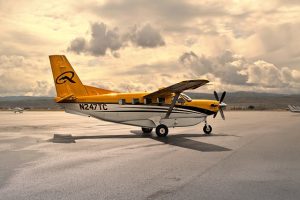
Have you heard of touch-and-go landings? It’s a common flight maneuver performed by pilots in training. According to the Federal Aviation Administration (FAA), commercial pilots need 1,500 hours of training. During their training, many pilots will perform touch-and-go landings to improve their ability to safely land the aircraft.
Overview of Touch-and-Go Landings
A touch-and-go landing is a flight maneuver that involves landing an aircraft and immediately taking back off without coming to a complete stop. During a touch-and-go landing, the pilot will “touch down” the aircraft on the runway, followed by taking back off.
Landings are typically regarded as one of the most difficult maneuvers to learn — even more so than takeoffs. Pilots must deploy the landing gear, adjust their speed and altitude, find the runway, communicate with Air Traffic Control (ATC), engage the brakes or reverse thrust and more. Pilots can practice landing procedures such as these, however, by performing touch-and-go landings.
Touch-and-Go Landing vs Normal Landing
A touch-and-go landing isn’t the same as a normal landing. During a normal landing, the pilot will come to a complete stop on the runway. Commercial airliners can achieve speeds of up to 650 MPH. When landing, though, the pilot will slow down the airplane so that it comes to a complete stop.
There is no stopping with a touch-and-go landing. As the name suggests, this alternative type of landing only involves “touching” the runway. The pilot will still slow down the airplane during the approach. After touching the runway, the pilot will then accelerate and take off back into the air.
A typical touch-and-go landing consists of the following:
- The pilot aligns the aircraft with the runway.
- The pilot adjusts the aircraft’s speed and descent rate.
- The pilot deploys the aircraft’s landing gear.
- The pilot touches the aircraft on the runway.
- The pilot takes back off.
The Purpose of Touch-and-Go Landings
The purpose of a touch-and-go landing is to give pilots a chance to practice both landing and takeoff techniques. This exercise is key for honing skills in crucial phases of flight. In a touch-and-go, the pilot brings the plane down for a landing, briefly touches the runway and then immediately takes off again.
Flight instructors frequently use this maneuver to train student pilots, allowing them to experience a variety of landing situations in a short time frame. It’s especially valuable for helping them get comfortable with controlling the aircraft during landing, managing speed and descent rates, and performing smooth takeoffs.



